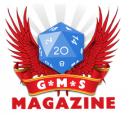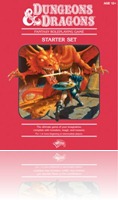As long-time readers of this blog already know, I’m not a big fan of the current direction of Dungeons & Dragons, an opinion I’ve held sincebefore the release of D&D IV. I was happy enough with the early days ofD&D III, but my mood changed for the worse around the time that v.3.5 was released, kicking off a quest of exploration that eventually landed me where I am today. So, if anyone is to blame for setting me down the path to old school gaming once again, it is Wizards of the Coast, but it was the previous “half-edition” that did so, not the one available now. D&D IV only solidified my already-existing opinion, which is why, for the most part, I’ve not had a lot to say about the game since its release, as you can see if you look over this blog’s nearly-2000 posts.
That said, I do have decidedly negative feelings about D&D IV, but they’re mostly of a very muted sort. Dismayed as I am by the turn the game has taken since 2008, I can’t really muster any real hatred for it. This is not a game I play, so why waste any energy in loathing it? Sure, I’d have preferred if WotC had adopted a more genuinely old school approach to their new edition, but then I wish the Star Wars prequels were better than they turned out to be too. For me,D&D IV isn’t generally on my radar and, if others are having fun with it, that doesn’t impact me one whit.
Still, when one of the players in the Dwimmermount campaign, who has played D&D IV, brought over a copy of the Starter Kit last weekend, I can’t deny that I was intrigued. Though I’m no fan of the Mentzer edition of the Basic Set from 1983, seeing its Elmore cover art gracing a WotC product did pique my interest. Clearly, this was meant to appeal to older gamers who never really warmed up to D&D IV. The Starter Kit looks to have been envisaged as a second chance to introduce the new edition to gamers turned off by its original hamfisted 2008 roll-out (“Zee game is zee same”). Score one for WotC on that, at least, because I did give the game a fresh look thanks to this box, although WotC earned no coin for their efforts. Had a friend not loaned me his copy, my interest would never have been enough to get me to fork over $19.95 for this boxed set and, having now read it, that situation hasn’t changed.
The contents of the set consist of two paperback rulebooks, a 32-page player’s book and a 64-page DM’s book — again, just like the Mentzer version — a sheet of tokens, power and magic item cards, a double-sided battlemap, and some dice. The box itself is really very nice: sturdy and deep. Indeed, its depth gives a false impression of just how much material is included in the boxed set, since the bulk of the box contains a cardboard tray. That said, there’s no denying it felt awesome to again hold a D&D boxed set in my hands. The books themselves felt very flimsy, like glossy laser-printed pages stapled together and with “covers” that are of the same quality — a pity. The map and cards likewise felt cheap to me and perhaps they were; I imagine WotC needed to cut corners to keep the costs down somehow.
The Player’s Book consists almost entirely of a choose-your-own-adventure type scenario that’s intended to introduce players new to tabletop roleplaying (more on that later) to D&D IV. In that respect, it does a pretty good job, since it expects only that the player choose a name, gender, and race before getting into the action. As the players makes his way through nearly 100 numbered sections of the scenario, he’s given choices that, besides advancing the action, also introduce game mechanics that are then explained in context. The result is a somewhat stilted “adventure,” but one that nevertheless decently presents theD&D IV rules piecemeal rather than in a giant technical manual-like infodump.
Now, I was already familiar with D&D IV’s rules, so very little in the Player’s Book was new to me. However, I won’t deny that this style of presentation was very clear, if a little hokey at times, but then I feel the same way about the Mentzer Basic Set’s similar approach. I’m clearly not the target audience for a product like this, though this raises the question of just why WotC decided to use Elmore art on the box cover (art that is not repeated on the inside, I should make clear), but that’s a topic for later in this review. As an introduction to the game for complete newcomers, though, I think the Player’s Book is rather good.
The Dungeon Master’s Book is, I think, a huge step up in complexity from the Player’s Book and necessarily so. That said, I found it a lot less “basic” than I was expecting it to be. There are far fewer well-meaning platitudes about the nature of being a referee here than I was expecting. Indeed, the book is extraordinarily light on the philosophy of refereeing, concentrating instead on the rules a DM needs to know in order to run an adventure. On the one hand, I think this is refreshing, far more useful than the usual silliness that passes for referee advice in a lot of RPGs these days. On the other hand, I do wonder if a genuine newcomer will get a good sense of what the DM is and what he needs to do from this book, nearly 20 pages of which consists of an adventure. Besides the rules and the adventure, there is a small selection of monsters included (about 20), and a too-brief overview of a genuinely interesting little sandbox setting, the Nentir Vale.
The Starter Set is a very strange product. It is not, at least from my perspective, much of a deviation from the standard D&D IV rules, though I’m by no means an expert on that score. From what I can see, the set’s rules are just a pared down version of what’s in the hardcover rulebooks, rewritten and presented in a less intimidating fashion for the benefit of newcomers. It is not by any means a “basic set” in the sense that that term is usually used. There are, for example, no independent rules for creating characters; to create a character one must go through the solo adventure to determine ability scores and to see which abilities and powers go with which races and/or classes. That’s fine as a tutorial, but, as a reference work, it leaves much to be desired. Furthermore, the material presented in the game is sufficient to handle a character only up to Level 2, after which one is directed to other supplements in this new line of D&D IV products. To my mind, that limits the utility of this boxed set even to D&D IV players; it’s essentially a one-trick pony to be bought, used briefly, and then to be put on the shelf to gather dust as you move on to the “real” products.
I’m far from a neophyte, so it’s hard for me to gauge how successful this product is as an introduction to the game. I think the Player’s Book is a pretty decent tutorial and I appreciate that the Dungeon Master’s Book opts for a no-nonsense, straightforward approach rather than the airy-fairy philosophical jabbering one usually gets in books aimed at referees. But I repeat: this is not a basic set for D&D IV. It is, like all of WotC’s intro efforts to date, a piece of crippleware designed to get you to buy into the larger game line. To be fair, the set does not claim otherwise. It calls itself a “starter set” and, as such, it does what it sets out to do but no more. I can now say I have a much better grasp of the D&D IV mechanics than I did before and, while my opinion of them hasn’t changed much, there’s no question that the Starter Set is better and more clearly written than, say, the Player’s Handbook.
But I remain confused about the use of the Elmore artwork. If this product is intended for true newcomers to roleplaying as it appears, then why use art from 25 years ago? If the product is intended to entice old school gamers into giving the new edition a second look, to prove that it really is “old school,” then why is it written the way that it is? Simply limiting options to the classic tetrad of character classes and races can’t hide the fact that, underneath it all, this is not, as the saying goes, “your father’s Dungeons & Dragons.” It’s a very different game, both mechanically and stylistically, and, while I don’t begrudge anyone who favors the new game (even if I do question their taste), I don’t see a lot here that’s of interest to fans of Gygax, Arneson, Holmes, Moldvay, or Mentzer.
I certainly can’t blame WotC for that. I doubt old schoolers constitute a large enough potential market to justify catering to their grouchy idiosyncrasies, especially when they’ve already got games to which they’ve stubbornly clung for decades, despite the march of “progress.” Reading through the Starter Set, though, did make me long for my old Holmes box. Boxed sets are no panacea for the declining state of the hobby, but there is something magical about them nonetheless. I wish WotC would, say, reissue the Holmes or even Moldvay boxed sets as “Classic Dungeons & Dragons,” like Hasbro has done for some of its other games. That’s something I’d buy without a second thought.
Presentation: 9 out of 10
Creativity: 6 out of 10
Utility: 3 out of 10
Buy This If: If you’re curious about D&D IV’s rules and don’t mind spending $19.95 for a well-presented but extremely limited introduction to them.
Don’t Buy This If: You either don’t care about D&D IV’s rules or are looking for a genuine “basic set” for the new edition.
This article was first published on the 12th September in Gornardia and all rights are reserved to James Maliszewski

